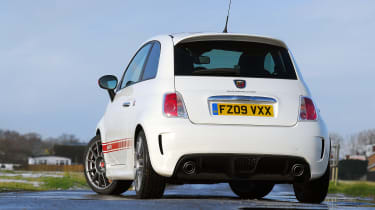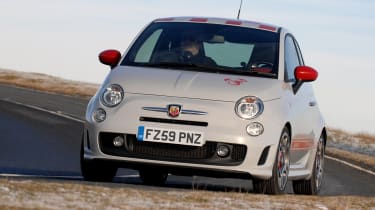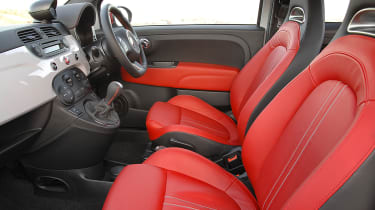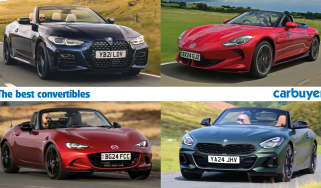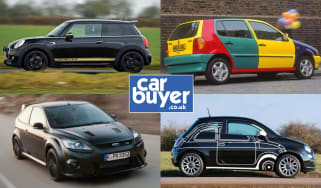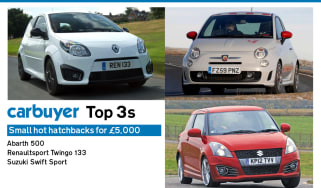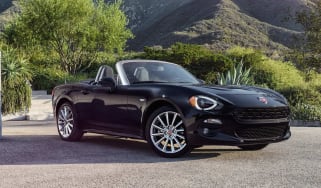Abarth 500 hatchback (2008-2016)
"The Abarth 500 is one of the most stylish small cars on the road and thanks to sharp handling and an eager engine, it offers driving thrills to match."
Pros
- Sporty looks
- Fun to drive
- Cheap to run
Cons
- Cramped interior
- Very firm suspension
- Expensive top-of-the-range models
The Abarth 500 is a performance version of the Fiat 500 city car, with sportier exterior looks, firmer suspension and a lot more power. The Abarth 500 has been on sale since 2008 and received a slight facelift and performance tweaks eight years later as it effectively morphed into the Abarth 595 and 695, which we’ve reviewed separately.
There’s much to like about the Abarth 500, as it reminds you of how simple hot hatchbacks once were before the wave of 300bhp+, technology-laden models arrived with high prices to match.
Fiat relaunched the Abarth brand in 2007 with a hot Fiat Punto, but the name really took off with the Fiat 500 Abarth. You can also get a 500 Esseesse version, which has even more power, larger wheels, harder suspension and bigger brakes.
The Abarth 500 was originally one of the most expensive hot hatchbacks. As the years have rolled by, the rivals were replaced and became more expensive. The 500 now sits in the lower end of the hot hatch market, with cars such as Volkswagen up! GTI.
The Abarth 500 range originally came in three main specification levels: Custom, Turismo and Competizione. From 2016, the 500 badge was dropped in favour of a range consisting of the 595, 595 Turismo, 595 Competizione and 695 Biposto.
More reviews
In-depth reviews
The 695 Biposto is a special stripped-out, race-bred version with a motorsport-style gearbox. Its rear seats have been removed and there's a distinct lack of luxuries on board, so it should probably be reserved for track days and occasional road use.
MPG, running costs & CO2
Automatic and manual versions of the Abarth 500 Custom and Turismo can return 43.5mpg and CO2 emissions of 150-155g/km, which means that, provided they were registered before tax changes on the 31 March 2017, they cost £200 a year to tax. The Competizione, meanwhile, can return a slightly more impressive 48.7mpg. The crazy Biposto model is capable of 37.9mpg and emissions of 145g/km. The facelifted 595 model achieves lower CO2 emissions of 139g/km meaning that under the new VED tax system, it costs £145 annually.
While higher running costs are to be expected with a performance model, the MINI Cooper S (which is faster on paper than the Abarth) can return economy of 49.6mpg.
All new Abarth models are available with an 'Easy Care' servicing plan which covers just about every aspect of the service - including parts, labour, software updates, as well as an oil and filter change - and can cover the car for up to five years for a single fixed price.
Engines, drive & performance
The entry-level Abarth 500 is powered by a 1.4-litre turbocharged petrol engine that produces 135bhp, accelerating the car from 0-62mph in 7.9 seconds and on to a top speed of 129mph. The newer 595 model uses the same engine, which now produces 140bhp.
The basic car's power can be boosted to 160bhp, which takes the 0-62mph time down to 7.4 seconds and raises the top speed to 131mph. The high-end Competizione model has 180bhp and does the 0-62mph sprint in 6.7 seconds. The special-edition 695 Biposto model takes the power even further to 187bhp, reducing the 0-62mph time to just 5.9 seconds.
Although the 500 has a five-speed gearbox, rather than the six-speed found in many rivals, the powerful engine means this doesn't hamper performance too much. All Abarths are fun in corners, thanks to stiff suspension that minimises body lean. Although tyre and wind noise can get quite loud, all Abarths have a nice exhaust sound that adds to their sporty appeal.
The racy Biposto model is available with either the standard five-speed manual gearbox or a five-speed racing transmission. The standard gearbox can be a little clunky and notchy in this model, especially if you take it on a track day, but it'll be easier to live with than the race version.
However, if you're already set on the Biposto, it's probably worth going all-out and investing £8,500 in the special transmission. An option costing a quarter of the price of the car is not something we'd normally recommend, but we're prepared to make an exception here.
Interior & comfort
While the firm suspension fitted to the Abarth is what makes it so much fun in corners, it also gives the car a hard ride. That means the Abarth 500 can be uncomfortable on badly surfaced roads. And while the sporty exhaust noise is fun when you're in the mood, it can become intrusive on a long journey.
The Competizione's sports seats should silence complaints about the standard 500's uncomfortable offerings by providing better support when you need it.
The Biposto model is definitely not for those who enjoy creature comforts, as it does without air-con and a radio for the purpose of saving weight. That's a hard pill to swallow in a car that costs £30,000.
Practicality & boot space
The Abarth 500 offers 185 litres of boot space, which is a little less than the MINI hatchback, but much less than what you get in a Citroen DS3. It's only really enough room for a small weekly shop or a few soft bags.
The split-folding rear seats improve matters by dropping down to expand the load capacity to 550 litres – however, if you go for anything other than the Turismo specification, you’ll have to pay an extra £153 to get them. As its Italian name suggests, the Biposto has only two seats, with the rears removed in favour of a roll cage and racing harnesses.
Thanks to its compact dimensions, the Abarth is very easy to park and manoeuvre around town, but its bigger wheels (which are easier to damage against kerbs) and weightier steering make it a slightly trickier prospect than your average city car.
Reliability & safety
Fiat's improved ranking in our 2019 Driver Power survey might inspire more confidence in the brand, as it came in 15th out of 30 manufacturers. The normal 500 itself was placed 58th out of the top 100 cars surveyed. That's still not a brilliant showing, but a mid-table result for reliability is a little more promising than in the past. The 500 didn't fare well for seat comfort, practicality or ride quality, though. Customer’s main gripes with Fiat’s cars were their practicality and infotainment.
Nonetheless, there have been no major faults reported on the 500, which uses many of the same mechanical parts and components as the Abarth. Interior build quality is also good, with expensive materials like leather and aluminium used throughout.
The Fiat 500 secured the maximum five-star rating in its 2007 Euro NCAP crash safety tests. It was retested in 2017, where it achieved a three-star rating - mainly due to the lack of advanced safety features that feature as standard in the latest new cars. It’s worth noting that all Abarths come with driver, passenger, side, curtain and knee airbags, as well as electronic stability control, hill-hold assistance and a system called 'torque transfer control' that maximises the grip of the front wheels.
Price, value for money & options
2019 prices for the Abarth 595 start from £16,685 and rise to £25,485 for the 595 Essesse and because of the limited number of cars available, you're unlikely to get a discount.
There's plenty of standard equipment, even on the entry-level model, but exterior styling touches such as decals and chrome cost extra, potentially pushing the price up by a considerable margin. Apple CarPlay and Android Auto are standard on revised 595 models with the Uconnect seven-inch infotainment screen.
Resale values on the used-car market remain impressively strong because of high demand, so the Abarth 500 should hold its value better than some of its competitors. Used prices in 2019 for the Abarth 500 start in the region of £4,000 for early cars around a decade old.

